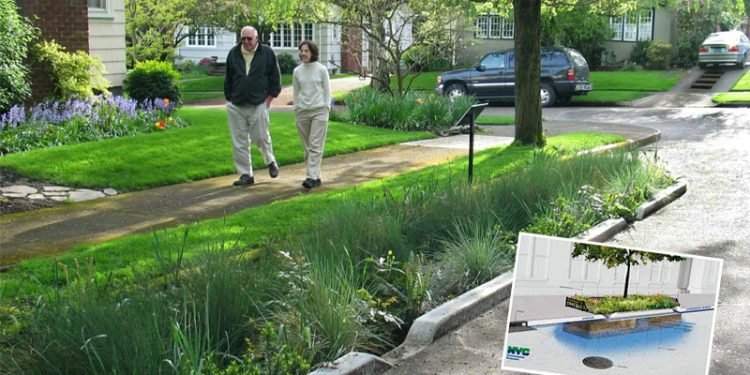Today at 10 a.m., the Council Transportation and Infrastructure Committee, chaired by Selvena Brooks-Powers, will take up the difficulty of stopping floods within the metropolis. Right here’s an opinion piece by a staffer at Transportation Options urging the Council to suppose extra broadly about infrastructure than simply what’s underground.
The climate is getting hotter, wetter, and extra harmful. We’re not going to desert these archipelagos we name house, so we have to make them extra resilient to local weather change. That begins with much less pavement and extra permeable surfaces.
As Hurricane Ida swept by means of New York Metropolis final fall, residences flooded, subway service shut down, and our streets become rivers. A complete month’s price of rain fell on New York in a matter of hours — and there was no place for the water to go.
When drains again up, stormwater searches for any opening it could discover — residences, subway grates, and station entrances. At current, 72 p.c of New York Metropolis’s land space is impervious to water, making flash flooding extra widespread and harmful.
Excessive climate just isn’t going away. Already this 12 months, we’ve seen subways flood from much less rain than Ida introduced. Our leaders should adapt New York Metropolis to guard our neighbors, our transit system, and our neighborhoods from the hazards flash flooding creates.
One rapid answer: Flip asphalt right into a resilience software.
We should rework impervious driving lanes into inexperienced local weather options. For instance, we must always construct bioswales — panorama parts designed to soak up and filter stormwater earlier than it enters the sewer system — instead of parking.
Even a single tree planted in a small pit can reduce rain runoff by round 60 p.c, even throughout the winter.
Metropolis leaders must be including these greenspaces citywide. Along with mitigating the danger of flood buildup throughout the town, parks, gardens, and bioswales are instruments to combat local weather change.
And, if asphalt may be reworked into an asset, New York Metropolis has a number of it.
Central Queens has 1,600 acres of roadbed. But proper of approach inexperienced infrastructure make up simply three acres, in line with a latest report from the Regional Plan Association.
Citywide, Mayor Eric Adams controls 6,300 miles of streets and three million free parking areas. By changing only a portion of that to greener and extra resilient makes use of, he can save lives and billions of {dollars}. A imaginative and prescient of what may very well be is printed in Transportation Options’ NYC 25×25 challenge, a name for our leaders to repurpose 25% of our streetspace to raised makes use of by 2025.
To start, he should repurpose a few of our road area for instruments reminiscent of bioswales, prioritizing areas in highest want. Whereas the lack of some free parking for inanimate objects might increase issues from a number of loud voices, it pales compared to the lack of life and livelihood within the aftermath of a storm.
Fairly than be the reason for, our streets can develop into the answer to local weather change and flooding. We want leaders with the imaginative and prescient and can to repurpose our streets into pathways for resiliency.









